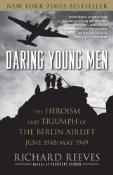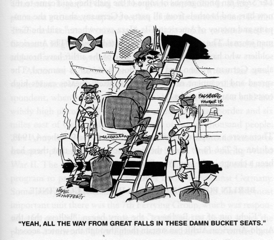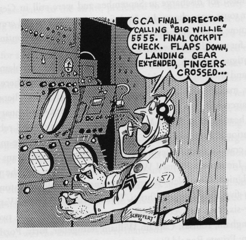
Daring Young Men By Richard Reeves
 Daring Young Men
Daring Young Men
The Heroism and Triumph of the Berlin Airlift June of 1948 to May of 1949
By Richard Reeves
Mention the Berlin Airlift today and chances are you will get a blank look. Those who took part in that amazing achievement deserve better.
 Reeves, writing with passion, reverence and humor, wants to make sure they will be remembered. Drawing on interviews, diaries, newspapers, biographies and government documents, he tells the story of the sixty thousand men and women who kept a ravaged city alive for more than a year; and the extraordinary leaders who made the Berlin Airlift possible: President Harry Truman, Generals Lucius Clay and Curtis LeMay, Colonel Frank Howley, and Major General William Tunner, who made it work, to mention a few. The book includes 6 pages of rarely seen photographs and, at the beginning of each chapter, a wonderful Jake Schuffert cartoon from the Task Force Times, a newspaper for airlift personnel.
Reeves, writing with passion, reverence and humor, wants to make sure they will be remembered. Drawing on interviews, diaries, newspapers, biographies and government documents, he tells the story of the sixty thousand men and women who kept a ravaged city alive for more than a year; and the extraordinary leaders who made the Berlin Airlift possible: President Harry Truman, Generals Lucius Clay and Curtis LeMay, Colonel Frank Howley, and Major General William Tunner, who made it work, to mention a few. The book includes 6 pages of rarely seen photographs and, at the beginning of each chapter, a wonderful Jake Schuffert cartoon from the Task Force Times, a newspaper for airlift personnel.
A brief historical recap may be helpful. At the end of WW11, Berlin was divided into four occupation sectors: Soviets in the eastern sector, Americans, British and French in western neighborhoods.
Allied bombers, artillery fire and Hitler’s order to “fight to the last man†had destroyed Berlin. The Soviets captured the city in 1945 and pillaged what was left. They sent whole factories and hundreds of thousands of pieces of industrial equipment to the Soviet Union, along with German technicians and managers. There were an estimated one million rapes during the 62 hellish days prior to the arrival of American troops.
Fast forward to three years later. The civilian population, mostly women, children, and old people, were still living in basements or in caves dug into the rubble and, according to a 1947 estimate by Clay’s staff, living on about 900 calories a day.
Hitler’s Reichsmark was nearly worthless making the black market the real economy of Berlin and American cigarettes the preferred currency,
Clay, Commander of all American troops in Europe, saw currency reform as the only way to return to some semblance of normality. Not everyone agreed. The Soviets hoped economic chaos would drive the city, and perhaps all of Germany, into their waiting arms. The French, having fought the Germans twice in 26 years, wanted Germany to be a poor agrarian nation.
On June 23, 1948, the western powers announced a new West German currency.  Within hours of the announcement the Soviets closed railway traffic on the line between Berlin and Helmstedt and roads connecting the Western sector to the rest of Germany. Except for air traffic, the Allied zones were cut off from all deliveries of food and fuel.
Curtis LeMay, Commander of United States Air Force Europe, viewed the Berlin crisis as “a logical outgrowth of the God-bless-our buddy-buddy-Russians-we-sure-can-trust-forever-and-ever-philosophy that flowered way back in the Roosevelt Administration.’ What he didn’t say was that the root of the Berlin problem was the political decision (apparently made at Yalta), to allow the Soviets to take Berlin.
Reeves writes that the American position was perilous.
There were hundreds of thousands of Red Army Troops… in and near East Germany. The Soviets also had more than 2.500 combat aircraft, fighters and light bombers in East Germany and another 1,500 or so in Eastern European countries. That compared with 16,000 Allied troops, most of them military police and engineers, fewer than 300 combat aircraft and perhaps 100 British fighters and bombers. There were another million or so Soviet troops in the rest of Eastern Europe, surrounding East Germany. Allied troop strength in all of western Germany was 290,000 men but only one or two combat ready brigades.
As Clay commented years later,
Remember this when the war ended we were sitting over there with the greatest army that had ever been seen, nobody was ever concerned about anybody blocking us on roads and railroads… The Japs surrendered and then the demand for bringing the troops home was great. With a relatively short period of time our military forces had deteriorated until they were nothing but young high school boys not wanting to be there.
It is no wonder that the Russians thought they could push us out of Europe. It did not appear that we were serious about staying.
Let’s make a joint effort, perhaps we can kick them out,â€Â Stalin said to William Pieck, Communist Party Leader of East Germany, March 19, 1948.
 The reaction of Colonel Frank Howley, Commander of Civil Government in the American sector of Berlin, was to announce: “We are not getting out of Berlin. We are going to stay.  I don’t know the answer to the current problem –not yet—but this much I do know: The American people will not allow the German people to starve.â€
The reaction of Colonel Frank Howley, Commander of Civil Government in the American sector of Berlin, was to announce: “We are not getting out of Berlin. We are going to stay.  I don’t know the answer to the current problem –not yet—but this much I do know: The American people will not allow the German people to starve.â€
That’s the back-story of the airlift. Reeves explains what happened next.
‘We stay in Berlin. Period.’ Truman said on June 29, 1948, after his military and diplomatic advisers told him there was no way for a few thousand allied soldiers to stand up to hundreds of thousands of Red Army Troops blockading the city.
The airlift began with 10-year old American C-47s left over from the war. The planes a British pilot had described in 1945 as, “A collection of parts flying in loose formation†were resurrected from abandoned British airfields and flown by any pilots who could be found.
In America, the first to be called up were those still on active duty.
This time [the soldiers] were supposed to free the people they had been trying to kill, and who had been trying to kill them, only three years earlier.
Noah Thompson, a farm boy from Vermont, had been a bomber and transport pilot in the Air Force. Within 24 hours of his arrival in Rhein-Main, he was piloting ten tons of coal to Tempelhof Airport in Berlin. He knew the territory. He’d flown 21 bombing missions over Germany in B-17s.
 Thompson was shocked when he saw the proximity of apartment buildings and the short, 6,100 ft of perforated steel planking laid on top of grass that was the single runway at Tempelhof.  “Pilots coming into Tempelhof did not exactly ’land,’ they dived for the ground.â€Â He saw Germans, mostly women, using wheelbarrows and shovels to fill holes, all the heavy equipment having been appropriated by the Soviets. The women ran to get out of his way but when Thompson looked back they were running behind him to continue working.
Thompson was shocked when he saw the proximity of apartment buildings and the short, 6,100 ft of perforated steel planking laid on top of grass that was the single runway at Tempelhof.  “Pilots coming into Tempelhof did not exactly ’land,’ they dived for the ground.â€Â He saw Germans, mostly women, using wheelbarrows and shovels to fill holes, all the heavy equipment having been appropriated by the Soviets. The women ran to get out of his way but when Thompson looked back they were running behind him to continue working.
At Gatow in the British sector, 30 Royal Air Force planes of every description landed the first day, June 26. They took off again as soon as they were unloaded. It was airborne chaos with different planes flying at different speeds and altitudes.
The US Air Force grabbed any planes capable of carrying cargo that happened to be on the ground in Germany, civilian or military didn’t matter.
Newer DC-4s were stripped of seats and bathrooms to be turned into air transports. “The airplane I had was the city of Denver, an American Airlines flagship,†said Corporal James Spatafora, who was in charge of rebuilding hydraulic systems at Rhein-Main.â€
Reservists were called up and civilians working for airlines recruited. The airlift needed pilots, mechanics, maintenance people, and air controllers.
The United States Armed Forces Medical Journal reported later:
Seldom, even in time of war, have persons been so rapidly removed from their homes or from established society as they were in the early stages of the airlift. Believing their departures would be for a matter of a few weeks, some left their families in tourist courts, some left their cars parked under trees, hiding the keys…Â
They solved the loading and unloading problem by hiring Germans.
 Everyone worked around the clock and it wasn’t enough. By July 23, there were only 2,500 tons of food and fuel flown into Berlin by British and American planes. Flying two round trips per 24-hour days both planes and men were breaking down. The conventional wisdom in America and Britain was the airlift was “doomed to failure.â€Â Secretary of Defense, James Forrestal, advised Truman to get out before the Soviets drove us out.
Everyone worked around the clock and it wasn’t enough. By July 23, there were only 2,500 tons of food and fuel flown into Berlin by British and American planes. Flying two round trips per 24-hour days both planes and men were breaking down. The conventional wisdom in America and Britain was the airlift was “doomed to failure.â€Â Secretary of Defense, James Forrestal, advised Truman to get out before the Soviets drove us out.
But Clay kept asking Truman for more planes and Truman kept sending them.
There was one man who believed it could be done. Major General William Tunner had directed the Hump operation over the 20,000-foot high Himalayan peaks during the war. Tunner was lobbying hard to get to Germany. He finally made it on July 29.
When Tunner arrived the daily airlift delivery averaged 1.985 tons, less than half the 4,500 minimum considered necessary to keep western Berlin going. Tunner performed a miracle of logistics and stubborn grit. On August 12, the target tonnage of 4,500 was reached for the first time.
Winter fog and frost made the airlift more difficult and more dangerous. Yet, on January 31, Tunner announced that “General winter be damned†the Americans and British had flown 171,960 tons of cargo into Berlin that month.  The cost was high, before the airlift ended, weather, pilot fatigue and inadequate maintenance would kill 73 western airmen.
By the beginning of March the cargo flown into the three Berlin airports was more than had been coming into the city by railroad and canal before the airlift began – 6,328 tons per day.
Reeves restores to memory one of America’s finest accomplishments. The airlift could not have succeeded without the British, but Britain was a war-ravaged country with problems of its own. The success of the airlift depended upon American money, materials, bravery, and humanitarianism.
Just as General Howley had predicted, the American people refused to let the German people starve. Geopolitical considerations aside, money collected in American schools, businesses and churches was used to charter planes to take packages of food and clothing to western Germany. The packages were then crammed into transports for delivery to Berlin.
The Soviets realized they had lost. A fact either ignored or not communicated to Stalin was that East Berlin depended upon the western sectors for raw materials. When the Allies retaliated with their own blockade, factories shut down and East Germans lost their jobs. On May 12, 1949, all road and rail routes from the West were reopened. It was a huge propaganda and political defeat for Stalin. Shortly afterward the West German Federal Republic and the North Atlantic Treaty Organization were formed.
This reviewer has always believed that Harry Truman was much under rated as a president. Richard Reeves’ book confirmed that belief. President Truman displayed great personal courage in supporting the airlift despite the advice of almost everyone in his administration. There was no such thing as “leading from behind†in the Truman White House. A looming presidential election he was widely predicted to lose did not alter his decision.
On Nov. 2, against all odds, Truman won the election. Polling indicated that public support for his stand on Berlin contributed to his victory.
There is much to learn from Reeves’ book. As history has demonstrated more than once, cutting defense without considering future needs can be a fatal error . Weakness encourages enemies and exacts terrible costs in blood and treasure. Without the courage demonstrated by Truman, the bravery of the air crews and the philanthropy of an exceptional people, freedom might be only a memory today in most, if not all of Europe.
This book would be a good antidote for what college students will learn from their professors. Daring Young Men should be on everyone’s Christmas list.
 The posts are coming!
The posts are coming!


0 comments
Kick things off by filling out the form below.
Leave a Comment